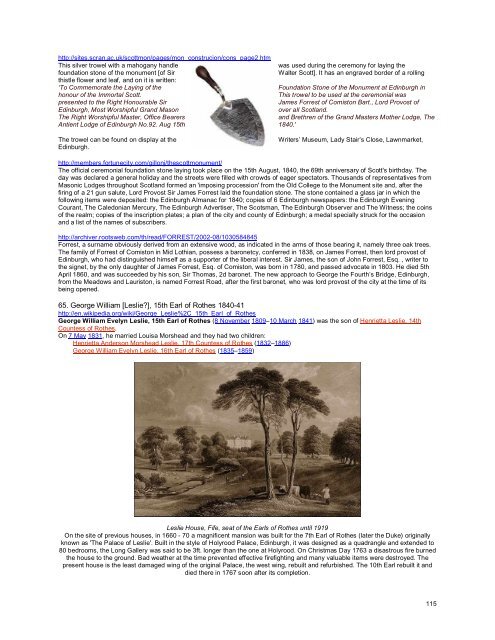Grand Masters of Scotland - Onondaga and Oswego Masonic ...
Grand Masters of Scotland - Onondaga and Oswego Masonic ...
Grand Masters of Scotland - Onondaga and Oswego Masonic ...
You also want an ePaper? Increase the reach of your titles
YUMPU automatically turns print PDFs into web optimized ePapers that Google loves.
http://sites.scran.ac.uk/scottmon/pages/mon_construcion/cons_page2.htm<br />
This silver trowel with a mahogany h<strong>and</strong>le<br />
foundation stone <strong>of</strong> the monument [<strong>of</strong> Sir<br />
thistle flower <strong>and</strong> leaf, <strong>and</strong> on it is written:<br />
To Commemorate the Laying <strong>of</strong> the<br />
honour <strong>of</strong> the Immortal Scott.<br />
presented to the Right Honourable Sir<br />
Edinburgh, Most Worshipful <strong>Gr<strong>and</strong></strong> Mason<br />
The Right Worshipful Master, Office Bearers<br />
Antient Lodge <strong>of</strong> Edinburgh No.92. Aug 15th<br />
The trowel can be found on display at the<br />
Edinburgh.<br />
was used during the ceremony for laying the<br />
Walter Scott]. It has an engraved border <strong>of</strong> a rolling<br />
Foundation Stone <strong>of</strong> the Monument at Edinburgh in<br />
This trowel to be used at the ceremonial was<br />
James Forrest <strong>of</strong> Comiston Bart., Lord Provost <strong>of</strong><br />
over all <strong>Scotl<strong>and</strong></strong>.<br />
<strong>and</strong> Brethren <strong>of</strong> the <strong>Gr<strong>and</strong></strong> <strong>Masters</strong> Mother Lodge, The<br />
1840.'<br />
Writers’ Museum, Lady Stair’s Close, Lawnmarket,<br />
http://members.fortunecity.com/gillonj/thescottmonument/<br />
The <strong>of</strong>ficial ceremonial foundation stone laying took place on the 15th August, 1840, the 69th anniversary <strong>of</strong> Scott's birthday. The<br />
day was declared a general holiday <strong>and</strong> the streets were filled with crowds <strong>of</strong> eager spectators. Thous<strong>and</strong>s <strong>of</strong> representatives from<br />
<strong>Masonic</strong> Lodges throughout <strong>Scotl<strong>and</strong></strong> formed an 'imposing procession' from the Old College to the Monument site <strong>and</strong>, after the<br />
firing <strong>of</strong> a 21 gun salute, Lord Provost Sir James Forrest laid the foundation stone. The stone contained a glass jar in which the<br />
following items were deposited: the Edinburgh Almanac for 1840; copies <strong>of</strong> 6 Edinburgh newspapers: the Edinburgh Evening<br />
Courant, The Caledonian Mercury, The Edinburgh Advertiser, The Scotsman, The Edinburgh Observer <strong>and</strong> The Witness; the coins<br />
<strong>of</strong> the realm; copies <strong>of</strong> the inscription plates; a plan <strong>of</strong> the city <strong>and</strong> county <strong>of</strong> Edinburgh; a medal specially struck for the occasion<br />
<strong>and</strong> a list <strong>of</strong> the names <strong>of</strong> subscribers.<br />
http://archiver.rootsweb.com/th/read/FORREST/2002-08/1030584845<br />
Forrest, a surname obviously derived from an extensive wood, as indicated in the arms <strong>of</strong> those bearing it, namely three oak trees.<br />
The family <strong>of</strong> Forrest <strong>of</strong> Comiston in Mid Lothian, possess a baronetcy, conferred in 1838, on James Forrest, then lord provost <strong>of</strong><br />
Edinburgh, who had distinguished himself as a supporter <strong>of</strong> the liberal interest. Sir James, the son <strong>of</strong> John Forrest, Esq. , writer to<br />
the signet, by the only daughter <strong>of</strong> James Forrest, Esq. <strong>of</strong> Comiston, was born in 1780, <strong>and</strong> passed advocate in 1803. He died 5th<br />
April 1860, <strong>and</strong> was succeeded by his son, Sir Thomas, 2d baronet. The new approach to George the Fourth’s Bridge, Edinburgh,<br />
from the Meadows <strong>and</strong> Lauriston, is named Forrest Road, after the first baronet, who was lord provost <strong>of</strong> the city at the time <strong>of</strong> its<br />
being opened.<br />
65. George William [Leslie?], 15th Earl <strong>of</strong> Rothes 1840-41<br />
http://en.wikipedia.org/wiki/George_Leslie%2C_15th_Earl_<strong>of</strong>_Rothes<br />
George William Evelyn Leslie, 15th Earl <strong>of</strong> Rothes (8 November 1809–10 March 1841) was the son <strong>of</strong> Henrietta Leslie, 14th<br />
Countess <strong>of</strong> Rothes.<br />
On 7 May 1831, he married Louisa Morshead <strong>and</strong> they had two children:<br />
Henrietta Anderson Morshead Leslie, 17th Countess <strong>of</strong> Rothes (1832–1886)<br />
George William Evelyn Leslie, 16th Earl <strong>of</strong> Rothes (1835–1859)<br />
Leslie House, Fife, seat <strong>of</strong> the Earls <strong>of</strong> Rothes until 1919<br />
On the site <strong>of</strong> previous houses, in 1660 - 70 a magnificent mansion was built for the 7th Earl <strong>of</strong> Rothes (later the Duke) originally<br />
known as 'The Palace <strong>of</strong> Leslie'. Built in the style <strong>of</strong> Holyrood Palace, Edinburgh, it was designed as a quadrangle <strong>and</strong> extended to<br />
80 bedrooms, the Long Gallery was said to be 3ft. longer than the one at Holyrood. On Christmas Day 1763 a disastrous fire burned<br />
the house to the ground. Bad weather at the time prevented effective firefighting <strong>and</strong> many valuable items were destroyed. The<br />
present house is the least damaged wing <strong>of</strong> the original Palace, the west wing, rebuilt <strong>and</strong> refurbished. The 10th Earl rebuilt it <strong>and</strong><br />
died there in 1767 soon after its completion.<br />
115







![Richard [Nicholls] Harison / Harrison - Onondaga and Oswego ...](https://img.yumpu.com/24950065/1/190x245/richard-nicholls-harison-harrison-onondaga-and-oswego-.jpg?quality=85)

![Richard [Nicholls] Harison / Harrison - Onondaga and Oswego ...](https://img.yumpu.com/24950063/1/190x245/richard-nicholls-harison-harrison-onondaga-and-oswego-.jpg?quality=85)







